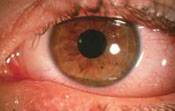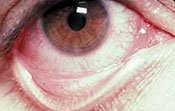Ocular itching, redness key to diagnosing allergic conjunctivitis

Allergic conjunctivitis is a common disease, affecting more than 20% of the U.S. population (Abelson, Smith and Chapin) and up to 30% of children worldwide (Gradman and Wolthers). With the international incidence of allergic conjunctivitis on the rise, largely due to industrialization and modernization (Majkowska-Wojciechowska and colleagues), more therapeutic agents are being developed for better management of the disease.
Assessment for clinical allergy trials
Ocular itching and redness are the primary identifying factors for a diagnosis of allergic conjunctivitis. Similarly, the screening and evaluation processes for clinical allergy trials revolves around the subjective assessment of ocular itching by the subject and the objective assessment of ocular redness by a trained clinician. Precise evaluation of the ocular allergic response as elicited by the Conjunctival Allergen Challenge (CAC) results in a subject population that is highly sensitive to allergen challenge, thereby allowing accurate analysis of ophthalmic anti-allergic medications.
Two models used when assessing medications for allergic conjunctivitis treatment are the CAC model and the hybrid environmental model. These methodologies have been integral in the regulatory approval of anti-allergic ophthalmic drugs in the United States, Europe and Japan, as well as 80 other countries. The sensitivity of each model to accurately measure a treatment effect depends on the screening procedures, which ensure that subjects are properly diagnosed with allergic conjunctivitis.
For subject entry into a trial, both models require a positive medical history of allergic conjunctivitis, a positive allergic skin test reaction within 2 years prior to study initiation and a positive ocular allergic reaction induced by a CAC.
The CAC model
The CAC model, developed in 1990 by Abelson, Chambers and Smith, is highly reproducible and capable of determining the precise onset and duration of a medication’s effect. Since the CAC’s inception, it has been used not only in regulatory and pivotal trials, but also as a tool to evaluate attributive properties of agents after marketing approval.
 Mark B. Abelson |
At the first study visit of a CAC study – the allergen titration visit – increasing allergen concentrations of the specific allergen that elicited a positive skin test reaction are instilled bilaterally at 10-minute intervals until a positive reaction is induced. Following challenge, ocular itching is evaluated by the subject, and redness is evaluated by trained clinicians; both evaluations use standardized rating scales that range from 0 (none) to 4 (severe).
Redness evaluations are made under the slit lamp, which allows for increased sensitivity in observing the three vessel beds. Investigators examine the four quadrants of the eye, as subjects can vary in the expression of ocular redness patterns in terms of location (temporal, nasal, superior or inferior) and prominence. Clinicians bring an added sensitivity to redness assessments, as these evaluations have not been matched by objective measurements in the form of instrumentation or computers.
A positive CAC reaction is defined as moderate to severe redness in two of the three vessel beds (conjunctival, ciliary, episcleral) of each eye and moderate to severe itching in both eyes within 10 minutes of allergen instillation. Subjects who fail to test positively are excluded from the study.
During the following visit, the allergen confirmation, patients are challenged with the final titer of allergen used in the first visit. If a moderate to severe ocular allergic response is reproduced at two out of the three post-CAC time points, the diagnosis is confirmed, and the subject is enrolled.
The hybrid environmental model
The hybrid environmental model, which incorporates a confirmatory CAC, was developed to address some of the variability issues associated with the traditional environmental model. The hybrid environmental model, through careful subject selection, has increased the reliability of the environmental model.
Subjects with a positive medical history of allergic conjunctivitis and a positive allergic skin test reaction to the allergen in season undergo a CAC. Subjects are titrated with low doses of the allergen in season, allowing for an enriched study population of only subjects who have high sensitivities to the allergen. This increases the likelihood that subjects will react to pollen on any day with detectable pollen levels. The model can therefore evaluate a drug’s performance during the allergy season.
Efficacy endpoints in clinical studies: Itching
Itching, which peaks 3 to 5 minutes after allergen exposure, is the hallmark symptom of allergic conjunctivitis, according to Abelson, Smith and Chapin. Itching indicates the release of histamine from conjunctival mast cells and the binding and activation of H1 receptors on nerve cells.
The key question clinicians ask when making a diagnosis of allergic conjunctivitis is: “Do you have itchy eyes/Do your eyes itch?” If itching is not present, then the patient does not have the disease.
Endpoint: Redness
Ocular redness, which begins within 10 minutes of allergen exposure, is a primary sign of allergic conjunctivitis. Upon mast cell degranulation, histamine and other vasoactive amines are released, causing vasodilation and increasing blood vessel permeability, which manifests as redness.
|
Images: ORA Clinical |
|
Endpoint: Other signs, symptoms
Chemosis, lid swelling and tearing are other signs and symptoms of allergic conjunctivitis, but they do not occur in all sufferers of the disease; mucous discharge is seen rarely. Due to the variability of manifestation patterns among individuals with allergic conjunctivitis, these signs and symptoms are seldom used as entry criteria for allergy studies. They are, however, often included as secondary efficacy points.
Nasal allergy symptoms occur concomitantly with ocular allergic symptoms. Indeed, studies by Scadding and colleagues and Wuthrich and colleagues show that 50% to 88% of allergic rhinitis patients also have ocular allergic symptoms. As such, nasal congestion, rhinorrhea, nasal/palate itching and sneezing are manifestations of ocular allergen instillation due to the drainage of allergens and allergic mediators through the nasolacrimal duct into the nasal passages.
The Food and Drug Administration does not currently have a clinical regulatory pathway for the approval of ocular agents for nasal allergies; however, studies by Abelson and Lanier and Spangler and colleagues have confirmed the connection between the eye and the nose, as well as the therapeutic benefit of ophthalmic drugs on the nasal allergic reaction.
Endpoint: Quality of life
Itching, hyperemia and other signs and symptoms of allergic conjunctivitis can lead to decreased quality of life among sufferers of the disease. The hybrid environmental model can determine the impact of an anti-allergic agent using measurements of quality of life, such as the Allergic Conjunctivitis Quality of Life Questionnaire by Mroz and colleagues. This instrument measures eye symptoms, symptom-related problems, activity limitations, emotional functions and vitality, and contains two daily efficacy questions.
The Rhinoconjunctivitis Quality of Life Questionnaire (RQLQ) is a sensitive tool from Berger and colleagues that evaluates the quality of life of allergic rhinitis and rhinoconjunctivitis patients. The RQLQ assesses ocular symptoms, nasal symptoms, non-nose and non-eye symptoms, global quality of life, activities, sleep, daily functioning and emotional impact.
When used in conjunction, these two tools can evaluate the effects of a drug on the quality of life, emotional functioning and daily life of individuals suffering from ocular and nasal allergies.
The success of any clinical trial hinges on the proper selection of the target disease population. For allergic conjunctivitis trials, the key diagnostic criteria for study entry are ocular itching and redness. Similarly, for the clinician, asking the patient, “Do your eyes itch?” is key to diagnosing allergic conjunctivitis. With the appropriate screening criteria, allergy studies can evaluate the efficacy and safety of drugs in development.
For more information:
- Mark B. Abelson, MD, an associate clinical professor of ophthalmology at Harvard Medical School and senior clinical scientist at Schepens Eye Research Institute, consults in ophthalmic pharmaceuticals. He can be reached at achervinky@oraclinical.com.
- Paul J. Gomes, MS, is the director of allergy at ORA Clinical Research and Development in North Andover, Mass. He can be reached at (978) 685-8900; e-mail: pgomes@oraclinical.com.
- Stephanie Leung is a medical writer at ORA Clinical Research and Development. She can be reached at (978) 685-8900; e-mail: sleung@oraclinical.com.
References
- Abelson MB, Chambers WA, Smith LM. Conjunctival allergen challenge. A clinical approach to studying allergic conjunctivitis. Arch Ophthalmol. 1990;108(1):84-88.
- Abelson MB, Gomes P, Crampton HJ, et al. Efficacy and tolerability of ophthalmic epinastine assessed using the conjunctival antigen challenge model in patients with a history of allergic conjunctivitis. Clin Ther. 2004;26(1):35-47.
- Abelson MB, Lanier RQ. The added benefit of local Patanol therapy when combined with systemic Claritin for the inhibition of ocular itching in the conjunctival antigen challenge model. Acta Ophthalmol Scand Suppl. 1999;(228):53-56.
- Abelson MB, Smith L, Chapin M. Ocular allergic disease: Mechanisms, disease sub-types, treatment. Ocul Surf. 2003;1(3):127-149.
- Abelson MB, Turner D. A randomized, double-blind, parallel-group comparison of olopatadine 0.1% ophthalmic solution vs. placebo for controlling the signs and symptoms of seasonal allergic conjunctivitis and rhinoconjunctivitis. Clin Ther. 2003;25(3):931-947.
- Berger W, Abelson MB, Gomes PJ, et al. Effects of adjuvant therapy with 0.1% olopatadine hydrochloride ophthalmic solution on quality of life in patients with allergic rhinitis using systemic or nasal therapy. Ann Allergy Asthma Immunol. 2005;95(4):361-371.
- Gradman J, Wolthers OD. Allergic conjunctivitis in children with asthma, rhinitis and eczema in a secondary outpatient clinic. Pediatr Allergy Immunol. 2006;17(7):524-526.
- Majkowska-Wojciechowska B, Pelka J, Korzon L, et al. Prevalence of allergy, patterns of allergic sensitization and allergy risk factors in rural and urban children. Allergy. 2007;62(9):1044-1050.
- Mroz M, Shapiro A, Abelson MB. Development of the allergic conjunctivitis quality of life (ACQLQ). Presented at DIA 9th Annual Symposium for Quality of Life Evaluations. Hilton Head Island, SC; 2002.
- Scadding GK, Richards DH, Price MJ. Patient and physician perspectives on the impact and management of perennial and seasonal allergic rhinitis. Clin Otolaryngol Allied Sci. 2000;25(6):551-557.
- Spangler DL, Abelson MB, Ober A, Gomes PJ. Randomized, double-masked comparison of olopatadine ophthalmic solution, mometasone furoate monohydrate nasal spray and fexofenadine hydrochloride tablets using the conjunctival and nasal allergen challenge models. Clin Ther. 2003;25(8):2245-2267.
- Wuthrich B, Brignoli R, Canevascini M, Gerber M. Epidemiological survey in hay fever patients: Symptom prevalence and severity and influence on patient management. Schweiz Med Wochenschr. 1998;128(5):139-143.


